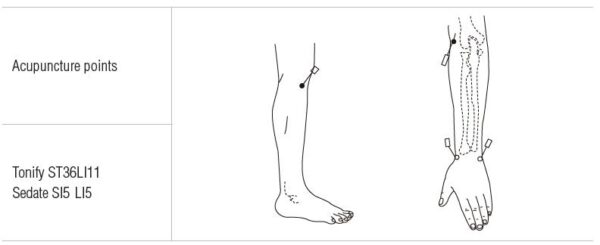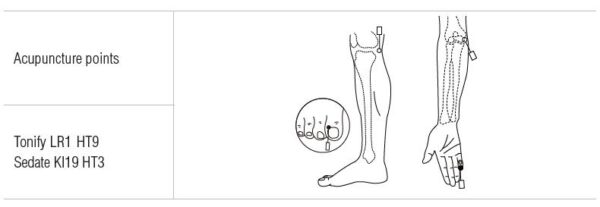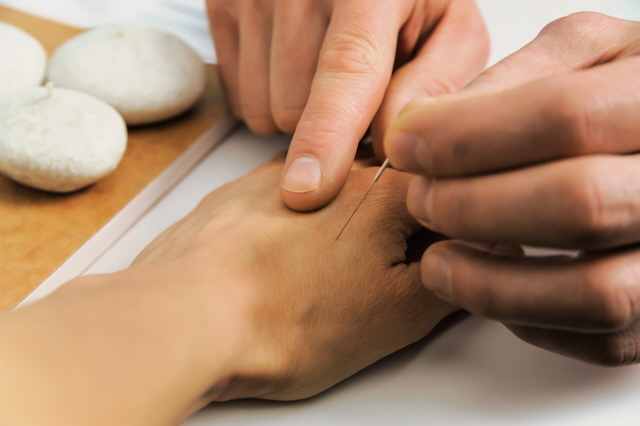- Sanghoon Lee, KMD, MPH, PhD, DiplAc, LAc Professor, Department of Acupuncture and Moxibustion, College of Korean Medicine Kyunghee university
- Dongwoo Nam, KMD, PhD Assistant Professor, Department of Acupuncture and Moxibustion, College of Korean Medicine Kyunghee university
- Jeongmin Ko, KMD, Dr.Jeongmin Ko’s Korean Medicine Clinic (Inc.) All that Korean Medicine
- Hyojung Kwon, KMD, PhD (Inc.) All that Korean Medicine
- Seung Min Kathy Lee, KMD, PhD, Research Fellow Department of Acupuncture and Moxibustion, College of Korean Medicine Kyung Hee University
- Park Jun Hyeong, KMD, MS, Researcher, Department of Acupuncture and Moxibustion, College of Korean Medicine
Kyung Hee University
Published in December 2017 by Korean Society of Acupuncture & Moxibustion Society
1. Clinical application (case)
1) Lung meridian
- (1) Jung-gyeuk: Tonify SP3, LU9 and sedate HT8, LU10. SP3 and LU9 are the Earth points of the Earth meridian and the Lung meridian, Earth generating Metal. HT8 and LU10 are the Fire points of the Fire meridian and the Lung meridian, Fire controlling Metal. These points control the excess of Dry heat by adding moisture and cooling function, thus generating bodily fluid. Lung jung-gyeuk relieves congestion of qi in the Upper Triple Energizer and the surface of the body. It also normalizes the descending function, which is used to treat weakness of the legs and degenerative diseases.

- (2) Seung-gyeuk: Tonifying Fire and sedating Water has the meaning of adding heat. It is used for diseases of the digestive system and genito-urinary diseases caused by coldness in the lower abdomen. Tonifying LI1, LR1, and SP1 is alternatingly used with Spleen seung-gyeuk to maximize dehumidifying effect.
- (3) Han-gyeuk: Tonifying HT3, LU5 and sedating KI2, LU10 is used for Fire symptoms caused by deficiency of yin energy. The symptoms include toothache of the mandible, tinnitus, dry nose, cold sweat, hot flush, and constipation. Equation for Phlegm caused by alcohol intake: tonifying SP3, LU9 and sedating LR1, SP1 is applied for hangover, alcoholic liver disease, as well as rosacea. Equation for congealed Blood: tonify SP3, LU9 and sedate LI11. There are variations. Tonify SP3, KI3 and sedate LI11; or tonify SP3, HT7 and sedate LI11 to focus on the circulation of Blood Tonify LI11 (and/or ST36) and sedate SP3 (and/or LU9) for relieving Damp Phlegm at the beginning of edema from contusion.
Add points such as SI3, BL60, SI8, and BL66 for problems of the lower abdomen.
Lung Jung-gyeuk is a very useful therapy when patients complain of common cold, shortness of breath, fatigue, etc. The signs to look for include dryness of the skin, shoulder pain, crimson colored tip of tongue, congestion of the white of the eye, etc. When the patient complains of profuse phlegm and cough the tonification and sedation of Lung Jung-gyeuk can be administered the other way. |
(2) Large Intestine meridian
- (1) Jung-gyeuk: Used for diseases caused by 1) Damp heat 2) innate weakness 3) tuberculosis of the neck. Tonifying ST36 and LI11 controls overwhelming Dampness and drops rising turbid yin energy. Sedating SI5 and LI5 cools Blood, thus prevents loss of bodily fluid by heat in the Blood, and helps normal generation of bodily fluid. Perpendicular needling of GB41 and LI3 is added to tonification of ST36 and LI11 for any pain symptoms on the Large Intestine meridian. A variation of this equation by tonifying ST36, LI11 and sedating SP3 is used in case there is only Dampness and no heat. If Kidney is weak KI3 is additionally sedated with this variation, resembling Kidney jung-gyeuk. For shoulder and brachial pain caused by Phlegm LI4 and LR3 are used instead of LI5.

- (2) Seung-gyeuk: Tonifying Fire and sedating Water has the meaning of adding heat. It is used for diseases of the digestive system and genito-urinary diseases caused by coldness in the lower abdomen. Tonifying LI1, LR1, and SP1 is alternatingly used with Spleen seung-gyeuk to maximize dehumidifying effect.
The Large Intestine Meridian is used for a variety of musculoskeletal problems, such as shoulder pain, elbow pain, and pain of the brachium. |
3) Stomach meridian
- (1) Jung-gyeuk: Tonifying SI5 and ST41 (sometimes ST36 is used instead of ST41) while sedating GB41 and ST43 1) has the meaning of dry yangming Metal that removes Dampness; and 2) controls the rise of Fire and heat by the Stomach’s original function of lowering qi.

- (2) Seung-gyeuk: Used for 1) blockage of qi movement that causes indigestion, constipation, nasal congestion, knee pain, stabbing pain in thin patients, palpebral edema; 2) dryness of skin and mucus.
- (3) Han-gyeuk: Tonifying BL66 (or GB43) and ST44 while sedating SI5 and ST41 is used when the heat of the Stomach is in excess and causes dry mouth, bad breath, frequent hunger, constipation, nausea, glossitis, ocular pain and congestion, toothache, nasal bleeding, sore throat, chest discomfort, insomnia, etc.
- (4) Yeol-gyeuk: Tonifying SI5 and ST41 while sedating BL66 and ST44 helps the warming yang energy of the gut and directly defeats stagnated coldness. Sedating ST44 in indigestion is effective for patients with cold Stomach factor.
- (5) Han-gyeuk + seung-gyeuk: Tonifying GB41 and ST43 while sedating SI5 and ST41 eliminates congested heat and wind thus treats illnesses of the head, face, and the facial features.
|
4) Spleen meridian
- (1) Jung-gyeuk: Tonifying HT8 and SP2 blocks the flooding of Dampness in the body caused by deficiency of Yang energy. Sedating LR1 and SP1 relieves the stagnation of Liver energy.

- (2) Seung-gyeuk: Tonifying LR1 and SP1 while sedating LU8 and SP5 is mainly to help the Wood energy. It relieves overloading of Spleen by such causes as Dampness or indigested food. This method moves Qi, motivates cleansing of the bowel and dehumidifies.
- (3) Han-gyeuk: Tonifying SP9 and KI10 (or LR8) while sedating HT8 and SP2 supplements the yin energy of the Spleen and Stomach and the deficient nourishing Blood. It is used for loss of appetite, dizziness, insomnia, anxiety, palpitation, failure of memory, dry and inflammated skin around the lips, hemorrhagic diseases, and female genital diseases.
- (4) Yeol-gyeuk: Tonifying HT8 and SP2 while sedating KI10 and SP9 directly relieves the stagnation of Dampness in the body. Asthenia of the Spleen, chronic indigestion, nausea after eating, cold hands and feet, diarrhea, fatigue, joint pain, eczema of scrotum, leucorrhea, etc. are treated with this equation.
|
5) Heart meridian
- (1) Jung-gyeuk: Tonifying LR1 and HT9 disperses the Heart energy while sedating KI10 and HT3 relieves the stagnation of Dampness and Phlegm caused by weak and deficient yang energy of Heart.

- (2) Yeol-gyeuk: Tonify HT8, LR2 and sedate KI10, HT3 when deficiency of Heart yang energy is eminent. Heart jung-gyeuk can be likened to the function of cinnamon and Heart yeol-gyeuk to that of aconitum.
- (3) Jung-gyeuk ver. II: Tonify SP3, HT7 and sedate KI10, HT3, considering the relationship of Heart and Spleen, for symptoms related to mental state.
- (4) Seung-gyeuk: Tonifying KI10, HT3 and sedating SP3, HT7 supplements yin Blood for heat symptoms and stabilized the mind. This equation is frequently used.
- (5) Seung-gyeuk ver. II: Tonifying KI10, HT3 and sedating LR1, HT9 is for heat symptoms caused by up rise of qi. This equation is even more frequently used than ver. I.
- (6) Han-gyeuk: Tonify KI10, HT3 and sedate LR1, HT8. This equation is used along with acupuncture points such as SP6, SP10, and SP8 for pseudo-heat symptoms caused by deficient Blood.
|

































